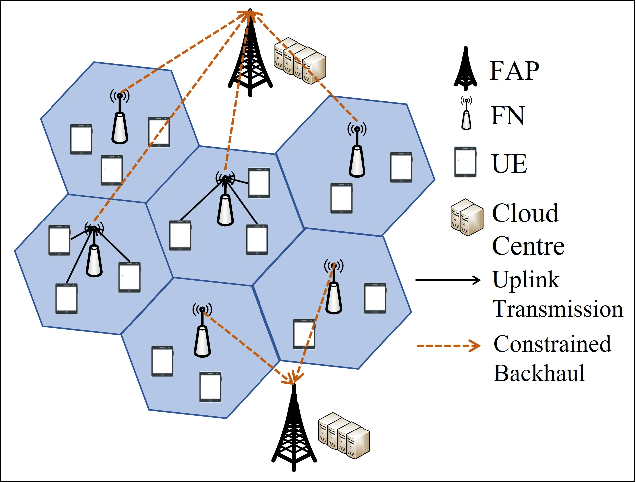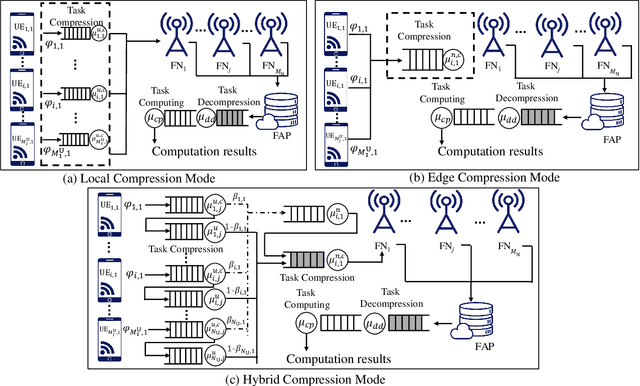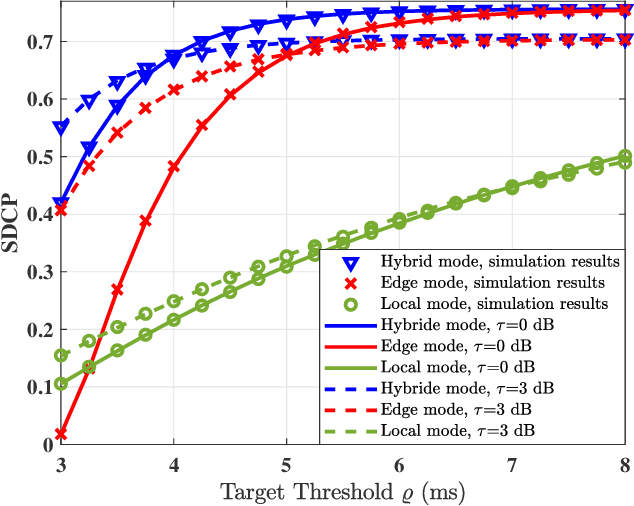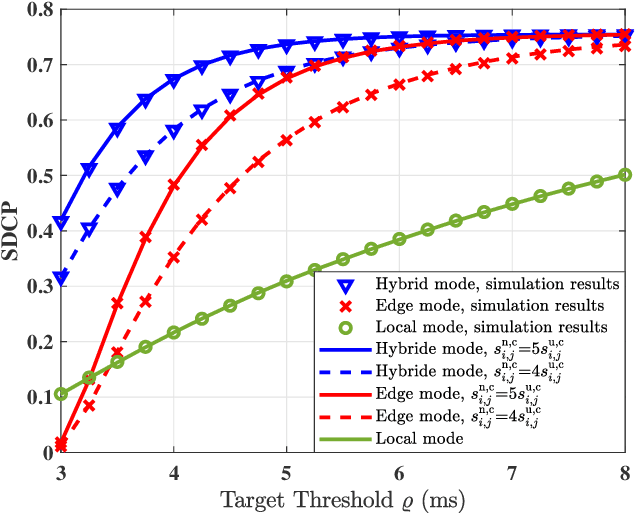Qianbin Chen
Low-Complex Channel Estimation in Extra-Large Scale MIMO with the Spherical Wave Properties
Oct 23, 2023Abstract:This paper investigates the low-complex linear minimum mean squared error (LMMSE) channel estimation in an extra-large scale MIMO system with the spherical wave model (SWM). We model the extra-large scale MIMO channels using the SWM in the terahertz (THz) line-of-sight propagation, in which the transceiver is a uniform circular antenna array. On this basis, for the known channel covariance matrix (CCM), a low-complex LMMSE channel estimation algorithm is proposed by exploiting the spherical wave properties (SWP). Meanwhile, for the unknown CCM, a similar low-complex LMMSE channel estimation algorithm is also proposed. Both theoretical and simulation results show that the proposed algorithm has lower complexity without reducing the accuracy of channel estimation.
A VHetNet-Enabled Asynchronous Federated Learning-Based Anomaly Detection Framework for Ubiquitous IoT
Mar 06, 2023Abstract:Anomaly detection for the Internet of Things (IoT) is a major intelligent service required by many fields, including intrusion detection, device-activity analysis, and security supervision. However, the heterogeneous distribution of data and resource-constrained end nodes present challenges for existing anomaly detection models. Due to the advantages of flexible deployment and multi-dimensional resources, high altitude platform stations (HAPSs) and unmanned aerial vehicles (UAVs), which are important components of vertical heterogeneous networks (VHetNets), have significant potential for sensing, computing, storage, and communication applications in ubiquitous IoT systems. In this paper, we propose a novel VHetNet-enabled asynchronous federated learning (AFL) framework to enable decentralized UAVs to collaboratively train a global anomaly detection model. In the VHetNet-enabled AFL framework, a HAPS operates as a central aerial server, and the local models trained in UAVs are uploaded to the HAPS for global aggregation due to its wide coverage and strong storage and computation capabilities. We introduce a UAV selection strategy into the AFL framework to prevent UAVs with low local model quality and large energy consumption from affecting the learning efficiency and detection accuracy of the global model. To ensure the security of transmissions between UAVs and the HAPS, we add designed noise to local model parameters in UAVs to achieve differential privacy. Moreover, we propose a compound-action actor-critic (CA2C)-based joint device association, UAV selection, and UAV trajectory planning algorithm to further enhance the overall federated execution efficiency and detection model accuracy. Extensive experimental evaluation on a real-world dataset demonstrates that the proposed algorithm can achieve high detection accuracy with short federated execution time and low energy consumption.
VHetNets for AI and AI for VHetNets: An Anomaly Detection Case Study for Ubiquitous IoT
Oct 14, 2022



Abstract:Vertical heterogenous networks (VHetNets) and artificial intelligence (AI) play critical roles in 6G and beyond networks. This article presents an AI-native VHetNets architecture to enable the synergy of VHetNets and AI, thereby supporting varieties of AI services while facilitating automatic and intelligent network management. Anomaly detection in Internet of Things (IoT) is a major AI service required by many fields, including intrusion detection, state monitoring, device-activity analysis, security supervision and so on. Conventional anomaly detection technologies mainly consider the anomaly detection as a standalone service that is independent of any other network management functionalities, which cannot be used directly in ubiquitous IoT due to the resource constrained end nodes and decentralized data distribution. In this article, we develop an AI-native VHetNets-enabled framework to provide the anomaly detection service for ubiquitous IoT, whose implementation is assisted by intelligent network management functionalities. We first discuss the possibilities of VHetNets used for distributed AI model training to provide anomaly detection service for ubiquitous IoT, i.e., VHetNets for AI. After that, we study the application of AI approaches in helping provide automatic and intelligent network management functionalities for VHetNets, i.e., AI for VHetNets, whose aim is to facilitate the efficient implementation of anomaly detection service. Finally, a case study is presented to demonstrate the efficiency and effectiveness of the proposed AI-native VHetNets-enabled anomaly detection framework.
On the Performance of Data Compression in Clustered Fog Radio Access Networks
Jul 01, 2022



Abstract:The fog-radio-access-network (F-RAN) has been proposed to address the strict latency requirements, which offloads computation tasks generated in user equipments (UEs) to the edge to reduce the processing latency. However, it incorporates the task transmission latency, which may become the bottleneck of latency requirements. Data compression (DC) has been considered as one of the promising techniques to reduce the transmission latency. By compressing the computation tasks before transmitting, the transmission delay is reduced due to the shrink transmitted data size, and the original computing task can be retrieved by employing data decompressing (DD) at the edge nodes or the centre cloud. Nevertheless, the DC and DD incorporate extra processing latency, and the latency performance has not been investigated in the large-scale DC-enabled F-RAN. Therefore, in this work, the successful data compression probability (SDCP) is defined to analyse the latency performance of the F-RAN. Moreover, to analyse the effect of compression offloading ratio (COR), a novel hybrid compression mode is proposed based on the queueing theory. Based on this, the closed-form result of SDCP in the large-scale DC-enabled F-RAN is derived by combining the Matern cluster process and M/G/1 queueing model, and validated by Monte Carlo simulations. Based on the derived SDCP results, the effects of COR on the SDCP is analysed numerically. The results show that the SDCP with the optimal COR can be enhanced with a maximum value of 0.3 and 0.55 as compared with the cases of compressing all computing tasks at the edge and at the UE, respectively. Moreover, for the system requiring the minimal latency, the proposed hybrid compression mode can alleviate the requirement on the backhaul capacity.
 Add to Chrome
Add to Chrome Add to Firefox
Add to Firefox Add to Edge
Add to Edge